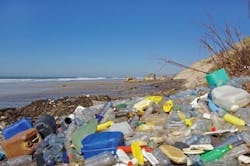About the author: Andrea Neal, Ph.D., is founder of Blue Ocean Sciences LLC. Neal can be reached at [email protected].
Parents are faced with a daily barrage of what is considered “safe”—government, industry, nonprofit groups and the scientific community all have varying and sometimes confusing opinions on this topic. This makes it hard to make the important decisions that keep you and your family out of harm’s way.
Recently, I came face to face with this issue in my own home, when bright yellow water began flowing from the tap. After spending an entire day trying to get a hold of my water company, I finally got someone on the phone. His answer was that it was just high mineral content from the wells, and because of the drought here in California, they could not flush the line.
Any parents out there know this is not a satisfactory answer when you have the health of your little ones to think about. All I could imagine was bathing my 10-month-old in what looked like urine, and trying to make his bottles with it.
I, of course, ended up testing the water at the Blue Ocean Sciences LLC lab, and found out we had high concentrations of the pesticides cyromazine and bendiocarb in our water. This was a recent development. When I had tested my water the previous month, there were only low levels of those compounds.
We installed a filtration system that resolved the pesticide issue, but lo and behold, we found phthalates in the treated water. Luckily, there were fairly low concentrations, so I could make an informed decision about what was worse: the high concentrations of pesticides or the low levels of phthalates.
Most of the time, people do not think about the safety of their water—as long as it looks, smells and tastes OK. It is only when they have defined reasons, like bad odors, colorations or taste issues, that they think about the quality of their water and whether it is truly safe—safe with which to make food, clean dishes or bathe a baby. When these questions are brought to the forefront, we realize how valuable this clean resource is and how hard life would be if we did not have it in abundance.
The sad truth, however, is that most toxins have no taste, odor or appearance, and long-term exposure to trace amounts can be hard to detect except at professional laboratories.
Phthalates & Plastic
At the Blue Ocean Sciences lab, I have been shocked by one set of compounds that appears to be almost ubiquitous in tap water today: phthalates. Every sample we have looked at, whether environmental or residential, has had some level of these compounds in it. Oftentimes, the levels are high, in the range of 50 to 700 ppb.
Phthalates are plasticizers used to make plastics hard or soft. They are used in a variety of products, including plastic water bottles, PVC piping, toys, pharmaceutical pill coatings, can coatings, food packaging, stabilizers, dispersants (such as for pesticides and air fresheners), lubricants, binders, emulsifying agents, suspending agents and more.
Plastic is a relatively new product, with mass production of modern plastics becoming widespread in the 1940s and 1950s. While still in its infancy as a product, plastic’s use in our everyday lives and the sheer number of items and infrastructure we use on a daily basis is astounding. While we cannot pinpoint exactly where phthalate exposure is happening, one theory is that it may be due to the changeover from metal to plastic pipe in homes.
In our own lab, we have seen this effect even on our analytical equipment. The plastic tubing, glues and parts were causing both contamination and false positives. As a result, we had to do a complete retrofit of the equipment to remove all plastics in line with the test stream.
Many phthalates are toxic, and they can impact people in a variety of ways. Effects of exposure may include endocrine disruption, which can increase the chances of cancer, specifically breast cancer. In infants, phthalates have been linked to developmental delays. These compounds also have been linked to asthma, allergies, wheezing, attention deficit hyperactivity disorder, feminization, obesity, diabetes and disruption of insulin production. As my pediatrician can tell you, phthalates can cause skin rashes and irritation in young children.
The reason phthalates are so active in small amounts is because in living animals, signaling molecules have evolved to have high gain (effectiveness), and phthalates effectively mimic these natural molecules.
Recently, our lab studied 100 miles of the Alaskan coastline. While remote, this coastline is littered with plastic trash. We were looking for radioactive heavy metals riding on currents from Fukushima, Japan, the site of the 2011 nuclear disaster. However, what we found was leaching of phthalates from the accumulated plastic in the area in significant levels in open water. This is further indication of how widespread the issue of phthalates affecting our resources is.
Like me, this probably makes your head hurt. However, I thoroughly believe the answers to our most dire environmental health issues already exist or can be developed. The overall message is that we have become reliant on these toxic compounds. They can impact our health, as well as the health of our families.
I truly believe that consumers have the biggest role to play in activating this change by putting their vote where their money is. So the next time you are in the store, think about that product you are about to purchase and its packaging. Take steps to minimize contact of these compounds to your family and water supply by avoiding synthetic clothing and buying products that are made with 100% cotton or hemp. And lastly, it may cost you more up front, but when it is time to change out the pipe under the sink, think about sticking with copper.
Download: Here
